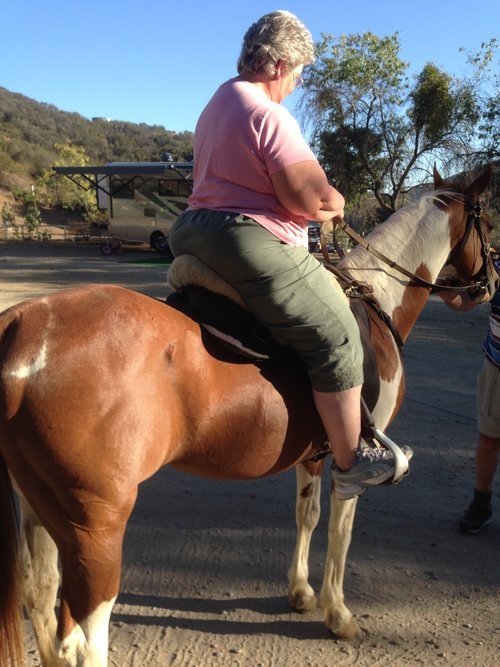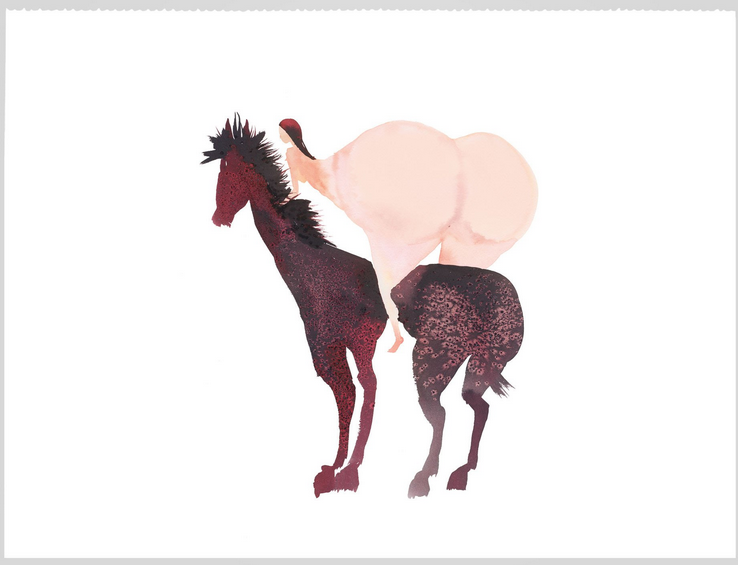AM I TOO FAT TO RIDE A HORSE?
by Colin Dangaard
The question has been asked for about 5,000 years, since humans first started riding horses. In the beginning, the horses were small, but so were the people. Horses weighed about 600 lbs, and humans averaged 120 lbs. But of course, riders began packing more stuff. Over the next thousand years weight increased even more. Armored Knights of Old were actually lowered onto their horses with pulleys, after two men fitted the saddle.
Advance to the South African War (1899-1902) and the average weight of an Allied Soldier was far more. A problem for the horse? Maybe, maybe not. A “scientific study” has concluded that a horse cannot comfortably carry more than 10 percent of its own weight. I have been looking for the punch line ever since: obviously this is a joke! This would mean 80 percent of the people riding horses today are too fat!
According to THE U.S.CAVALRY MANUAL OF HORSE MANAGEMENT (1941) a horse should not carry more than 20 percent of its own weight. This edict was routinely exceeded, soldier and equipment regularly weighing 250 lbs.
Researchers at Duchy College, in Cornwall, England, studied horse impact from 50 riders executing 45-minute workouts and they too came up with the 20 percent recommendation. This was ascertained by monitoring the release of creation kinase, an enzyme present in the muscle and released into the blood to restore muscle damage. This enzyme is triggered when an increasing heart rate releases plasma lactate to levels the horse’s body cannot metabolize.
Of course, the scientists noted that impact on the horses varied greatly. Those with wider loins and thicker cannon bones recovered more quickly. Experienced riders know fit of saddle is vital.
For most of the 5,000 years men have been riding horses they have used them to go places to kill each other. Pleasure riding, as we know it today, is maybe 100 years old!
The earliest warriors rode bareback and all horses were sored within three days. As weapons and armor increased in weight, so did the structures needed to carry them on the back of a horse. Attila the Hun was the first to use a saddle in war, figuring spreading the bearing weight over a greater area would make the horse less sore. He was a PSI pioneer!
Attila stole this idea from the Sarmatians (400 BC) who built a wooden “casing” on a horse so they would not be ejected when they ran a lance through an enemy ground soldier. They invented mounted lance warfare.
Next, Attila stole a stirrup the Chinese used as a mounting aid during the same period. Amazingly it took 800 years for somebody (Attila) to think of putting a second stirrup on the other side!
The Romans soon visited Attila’s discovery but were quick to establish weight limits. “Cloak bags” were not to weigh more than 35 lbs, saddles not more than 56 lbs. Add this to 200 lbs of an average armed warrior and the Roman warhorse carried 300 lbs, well over 30 percent of its weight. A soldier with equipment was around 320 lbs. For the British Desert Mounted Corps in Palestine and Syria (1917-1918) the typical weight carried was 290lbs, “all day and every day,” according to saddle historian Major G. Tylden.
Hitler had the most mechanized Army the world had ever seen, yet he had three million horses under his command. They carried 250 lbs to protect his Tiger Tanks.
For the war in Afghanistan, I saddled 130 horses for the US Special Ops, also designing scabbards for their M4s. Those horses packed 250 lbs.
Today, for the first time in the long man/horse partnership we are not eating them or causing them to die in battle. We are actually enjoying them and, I like to believe, they are enjoying us.
Ironically, all this feel-good stuff has happened as humans have grown SUBSTANTIALLY. In the last 50 years we have outgrown airplane seats, cars, furniture and houses. When I started putting Americans in Australian stock saddles in 1979 the average seat size (Australian) was 16”. Today it is 17” and rising.
But the horse has NOT changed. Clearly, humans and horse are on a weight-impact collision course.
The good news is, people are asking themselves: am I too fat to ride?
"Whoa, Nellie, whoa!"
You are too fat to ride a particular horse if the animal is in obvious discomfort. The signs are clear. First, the horse is reluctant to go forward. He wants to stand so his front legs remain as close as possible to his back legs, thus giving more support to the "bridge" that is his back. If you can get him to move, he will take shorter steps. This is a horse's natural way to handle great weight. Going forward, breathing becomes heavier after a fairly short time, like half an hour on flat ground. This is as much because of stress as it is because of physical exertion. The horse has trouble going up a hill, he stumbles because he cannot get his front legs under him. He cannot sufficiently lift his front end.
IF ANY OF THIS HAPPENS, DO NOT RIDE THIS HORSE. Of course, a different horse may not exhibit any of these symptoms with the same rider. Simply put: some horses can carry more weight. They have genetically stronger skeletons. But each and every one has a limit.
I consider reality rather than listen to scientists, who can crunch numbers and come up with any result they want to push an agenda. I suspect much of the weigh-impact-on-horse dialogue is advanced by people who do not want us to do ANYTHING with animals other than look at them. Easy to imagine that in 200 years humans riding animals will be illegal.
Meanwhile, horse lovers are taking note. Bayard Fox, owner of Equitours, sends people to dozens of countries to ride horses – but he has a weight limit of 200 lbs. Still, he does not chisel that in stone, explaining: “In actuality, we have felt that some riders weighing 210 pounds were easier for horses to carry than some people weighing only 175 pounds.”
Bottom line: riders who move WITH a horse are “lighter” than people of the same weight who “ride like a sack of potatoes.”
There is a popular misconception that big people should ride big horses. The reality is that smaller horses can carry a higher proportion of their own weight than bigger horses. In the trench warfare of World War 1 Connemara ponies carried HALF their body weight all day long. Mules and donkeys do the same today.
Endurance rider Ed Anderson rode his 14.3 hand 900-lb Arabian gelding Primo 2,000 miles from Mexico to Canada carrying up to 275 lbs-- around 36 per cent of its body weight. “I went solo and unsupported,” he says. “Primo had no problems.”
But as Dr Gary Carlson DMV cautions: “Every extra pound a horse has to carry from point A to point B requires that much more energy.” As a member of the American Endurance Ride Conference’s Veterinary Committee, Dr Carlson knows reality.
There's world renowned tattoo artist Pat Fish, of Santa Barbara, using a crane to lower her Western saddle on her trusty mule TOBE. Pat is the first to admit she is no pixy dancer, and her saddle is no jockey saddle, but TOBE shows clearly that mules have a ton of power to carry weight. As Pat says: "TOBE hauls me up and down hills for hours and days, no problem. He is enthusiastic and never gets tired."


![IMG_1890[1] - Copy.JPG](https://images.squarespace-cdn.com/content/v1/586aa724ebbd1a367d325505/1488946717409-RD07HZPTYHMWR4XUFXI9/IMG_1890%5B1%5D+-+Copy.JPG)


